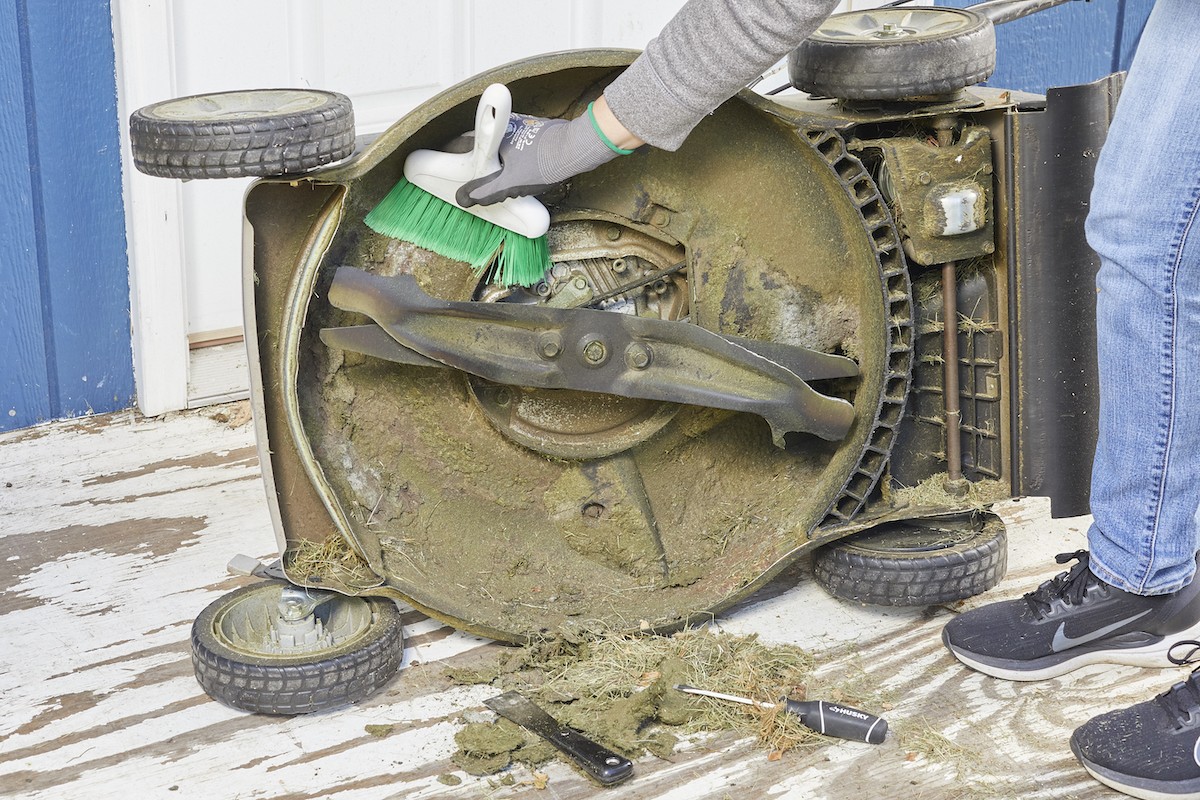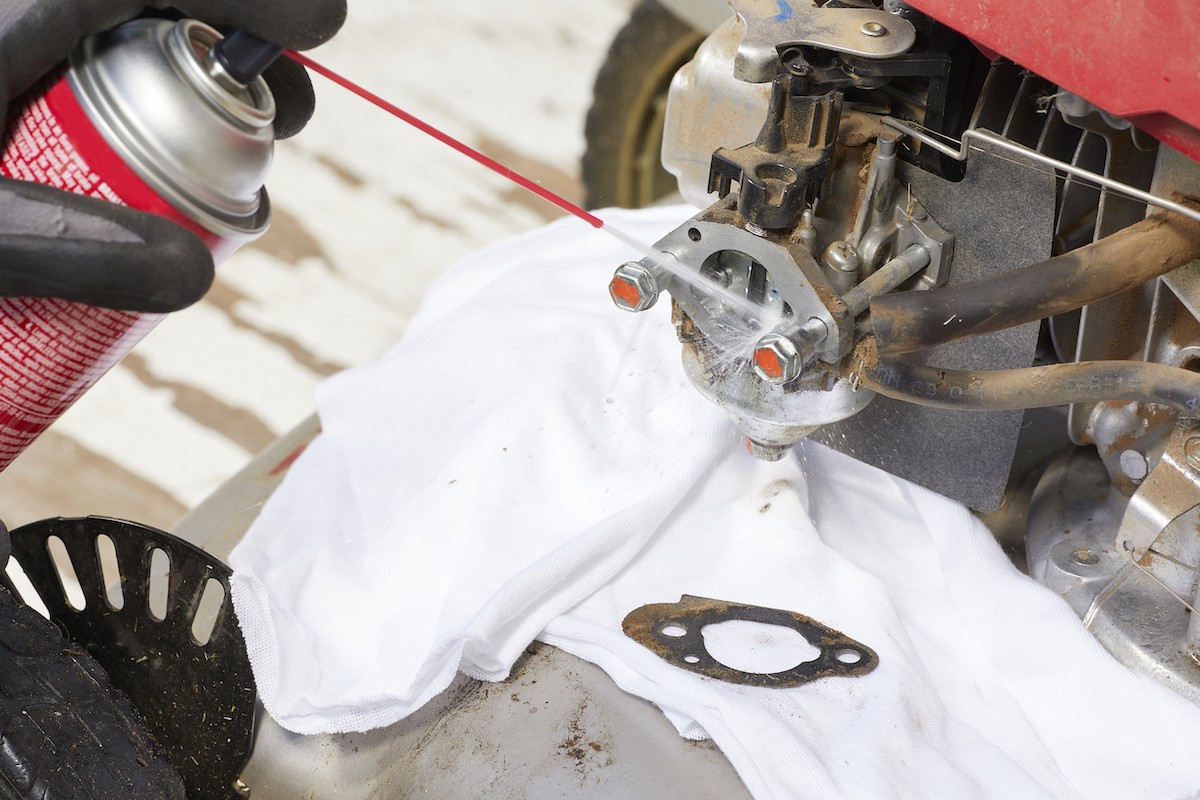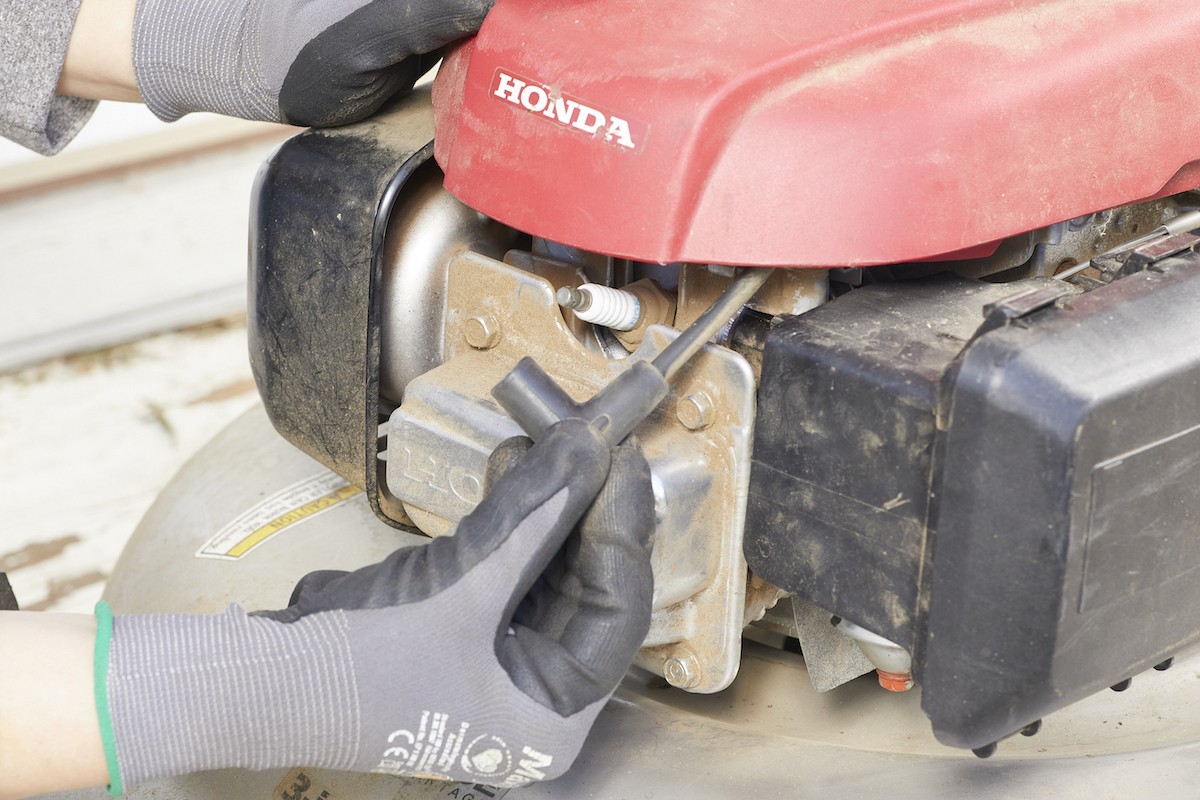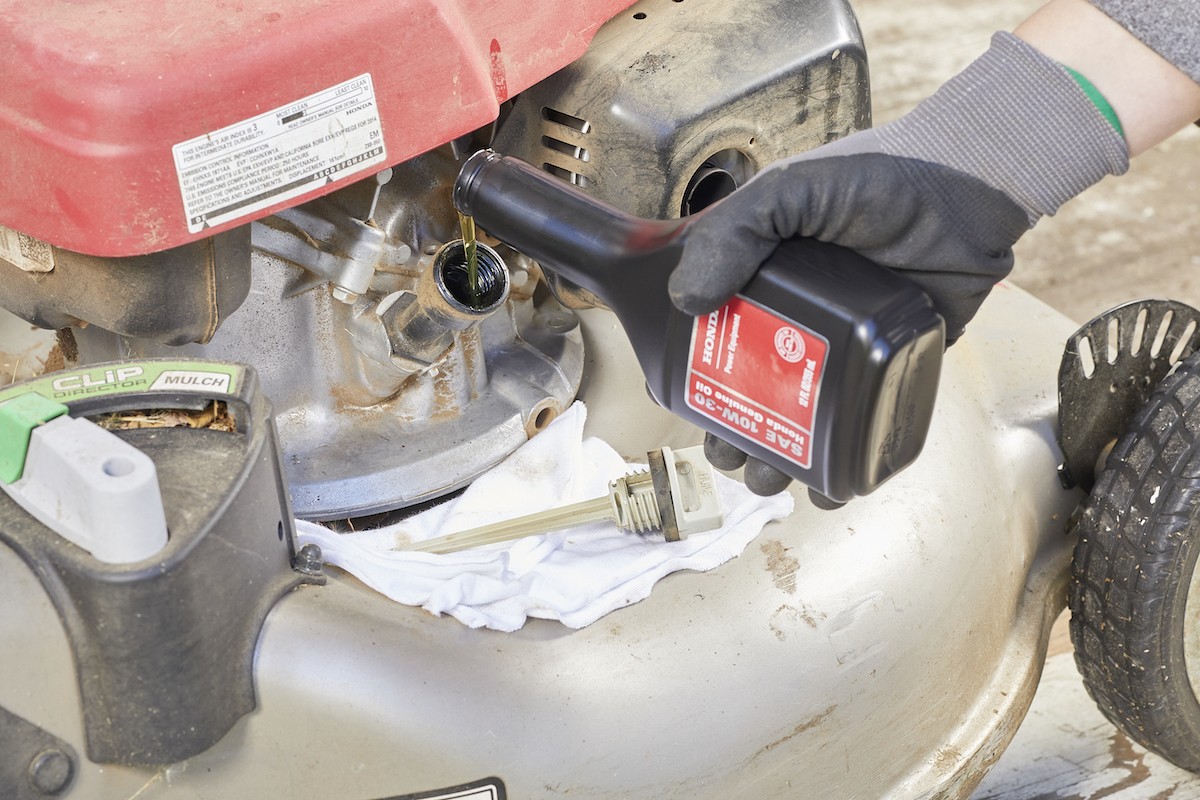Is your lawn mower refusing to roar to life? Why is it that your lawn mower won’t start? At WHY.EDU.VN, we understand the frustration of a silent mower, especially when lawn care calls. This comprehensive guide will walk you through the most common culprits and provide practical solutions to get your machine running smoothly again, focusing on engine starting problems and offering helpful advice. Learn about fuel issues, spark plug problems, and simple fixes for your lawn equipment.
1. Check and Refill the Fuel Tank with Fresh Gasoline
One of the simplest and most frequently overlooked reasons why a lawn mower won’t start is the fuel. Is the tank empty, or is the gas old and stale? Shawn Carothers, Senior Marketing Manager at Toro, emphasizes the importance of fresh fuel, less than 30 days old. Stale gas can lose its combustibility, leading to engine starting problems.
- Solution: Drain any old fuel using a siphon pump, ensuring you dispose of it responsibly. Refill the tank with fresh gasoline. This simple step can often resolve the issue. If the problem persists, explore other fuel-related issues like a dirty carburetor or fuel line blockage.
2. Clear Grass Clippings from the Mower Deck
A buildup of grass clippings under the mower deck can prevent the blade from turning freely, causing the engine to stall or refuse to start. This is especially common when mowing wet lawns, as grass clippings tend to clump together.
- Solution: Turn off the mower and disconnect the spark plug wire for safety. Tip the mower on its side and use a trowel or scraper to remove any accumulated grass clippings. Clean the blades and ensure they can rotate without obstruction. After cleaning, the lawn equipment should be ready to go.
3. Inspect and Replace the Air Filter
The air filter protects the engine from dirt and debris. A clogged air filter restricts airflow, leading to poor engine performance and starting difficulties. Regular lawn mower maintenance includes keeping the air filter clean to prevent engine issues.
- Solution: Locate the air filter (refer to your owner’s manual). If it’s a paper filter, replace it. If it’s a foam filter, wash it with hot, soapy water, allow it to dry completely, and then lightly oil it before reinstalling. This helps maintain optimal engine function.
4. Examine the Spark Plug for Damage or Fouling
The spark plug ignites the air-fuel mixture in the engine. If it’s fouled, damaged, or improperly connected, the engine won’t start. Checking the spark plug is a crucial step in diagnosing engine starting problems.
- Solution: Disconnect the spark plug wire and remove the spark plug using a socket wrench. Inspect the electrode for signs of wear, corrosion, or carbon buildup. Clean the spark plug with a wire brush or replace it if necessary. Ensure the spark plug gap is set correctly before reinstalling.
5. Check the Fuel Filter for Clogs
The fuel filter prevents dirt and debris from entering the carburetor. A clogged fuel filter restricts fuel flow, causing the engine to stall or not start at all. Ensuring the fuel system is clean is part of regular lawn mower maintenance.
- Solution: Locate the fuel filter (refer to your owner’s manual). Disconnect the fuel lines and check for fuel flow. If the filter is clogged, replace it with a new one. Using a fuel stabilizer can help prevent future buildup.
6. Clear the Vent in the Fuel Cap
The fuel cap vent allows air to enter the fuel tank, maintaining proper pressure for fuel flow. If the vent is blocked, a vacuum can form in the tank, preventing fuel from reaching the engine. This simple fix can address fuel delivery issues.
- Solution: Remove the fuel cap and check the vent for any obstructions. Clean the vent with a small wire or compressed air. Reinstall the fuel cap and try starting the mower.
7. Inspect the Safety Release Mechanism Cable (Dead Man’s Control)
The safety release mechanism, often called the “dead man’s control,” is designed to stop the engine when the operator releases the handle. If the cable is damaged, stuck, or improperly adjusted, it can prevent the engine from starting. This is a key safety feature to check during lawn mower maintenance.
- Solution: Inspect the cable and ensure it moves freely. If it’s damaged or broken, replace it. Ensure the safety interlock disengages when the handle is squeezed.
8. Verify Flywheel Brake Engagement
The flywheel brake stops the engine quickly when the operator releases the handle. If the brake is engaged or misaligned, it can prevent the engine from starting. Checking the flywheel is essential for addressing engine starting problems.
- Solution: Ensure the brake pad makes full contact with the flywheel and that there isn’t anything jamming the blade. If the flywheel key is sheared, it may need to be replaced, requiring disassembly of the mower.
9. Investigate Other Possible Causes
If none of the above solutions work, consider these less-common reasons why a lawn mower won’t start:
- Ignition Switch Malfunction: The switch may be faulty or not making proper contact.
- Water in the Fuel Line: This can prevent the fuel from combusting.
- Incorrect Choke Adjustment: Adjusting the choke improperly can lead to too much or too little fuel mixing with air.
- Low Oil Levels or Old Oil: This can increase friction and make starting more difficult. Regular oil changes are part of lawn mower maintenance.
10. Signs You Need Professional Lawn Mower Repair
While many lawn mower issues can be resolved with DIY fixes, some problems require the expertise of a professional. Here are some signs that it’s time to call a pro:
- Black Smoke: Indicates a cracked engine or worn-out components.
- Excessive Oil or Gas Consumption: Suggests a problem beyond routine maintenance.
- Knocking Sound: May indicate bent or misaligned parts.
- Vibrating or Shaking Lawn Mower: Suggests a loose or misaligned component.
If you’ve tried the above solutions and your lawn mower still won’t start, it might be time to seek professional assistance.
11. Understanding Different Types of Lawn Mowers
Different types of lawn mowers may have specific starting issues. Understanding these differences can help in troubleshooting:
- Gas-Powered Lawn Mowers: These mowers typically have the issues discussed above, such as fuel problems, spark plug issues, and air filter clogs.
- Electric Lawn Mowers: Electric mowers may have issues with the battery, power cord, or motor.
- Riding Lawn Mowers: These mowers often have additional safety features and components that can cause starting problems, such as seat switches and interlock systems.
12. Seasonal Lawn Mower Maintenance Tips
Proper seasonal maintenance can prevent many starting problems. Here are some tips:
- Spring: Check and replace spark plugs, air filters, and fuel filters. Change the oil and sharpen the blades.
- Summer: Regularly clean the mower deck and ensure proper ventilation.
- Fall: Prepare the mower for winter storage by draining the fuel, cleaning the mower, and storing it in a dry place.
- Winter: Perform any necessary repairs and maintenance tasks to ensure the mower is ready for the next mowing season.
13. Safety Precautions for Lawn Mower Maintenance
Safety should always be a priority when performing lawn mower maintenance. Here are some precautions to follow:
- Disconnect the spark plug wire before performing any maintenance to prevent accidental starting.
- Wear safety glasses to protect your eyes from debris.
- Wear gloves to protect your hands.
- Work in a well-ventilated area when working with gasoline.
- Properly dispose of old gasoline and oil.
14. DIY vs. Professional Lawn Mower Repair: Making the Right Choice
Deciding whether to repair your lawn mower yourself or hire a professional depends on your skills, experience, and the complexity of the problem. Here’s a breakdown:
| Factor | DIY Repair | Professional Repair |
|---|---|---|
| Skills | Basic mechanical knowledge, ability to follow instructions | Extensive knowledge of lawn mower mechanics |
| Experience | Some experience with small engine repair | Years of experience diagnosing and repairing lawn mowers |
| Complexity | Simple tasks like changing spark plugs, air filters, and fuel filters | Complex repairs like engine rebuilds, electrical system repairs, and transmission work |
| Tools | Basic tools like wrenches, screwdrivers, and pliers | Specialized tools like compression testers, multimeters, and engine analyzers |
| Cost | Lower initial cost, but potential for additional expenses if mistakes are made | Higher initial cost, but guarantees quality workmanship and proper diagnosis |
| Time | Can be time-consuming, especially if you’re learning as you go | Faster turnaround time due to expertise and specialized equipment |
| Warranty | No warranty on DIY repairs | Warranty on parts and labor |




15. Common Lawn Mower Brands and Their Specific Issues
Different lawn mower brands may have specific issues that are common to their models. Here are some examples:
- John Deere: Known for their reliability, but may have issues with their electrical systems and carburetors.
- Toro: Known for their easy-to-use features, but may have issues with their self-propelled systems and blade engagement.
- Craftsman: Known for their affordability, but may have issues with their engines and transmissions.
- Honda: Known for their durable engines, but may have issues with their starting systems and fuel lines.
16. Lawn Mower Troubleshooting Checklist
Here is a handy checklist to guide you through the troubleshooting process:
- Check the Fuel: Ensure the tank has fresh gasoline.
- Clear the Mower Deck: Remove any accumulated grass clippings.
- Inspect the Air Filter: Clean or replace if necessary.
- Examine the Spark Plug: Clean, gap, or replace if needed.
- Check the Fuel Filter: Replace if clogged.
- Clear the Fuel Cap Vent: Ensure it’s not blocked.
- Inspect the Safety Release Mechanism Cable: Ensure it moves freely.
- Verify Flywheel Brake Engagement: Ensure it’s properly disengaged.
- Check Oil Levels: Low oil can prevent the mower from starting.
17. Using a Multimeter for Lawn Mower Electrical Issues
A multimeter is a valuable tool for diagnosing electrical issues in your lawn mower. Here’s how to use it:
- Safety First: Disconnect the spark plug wire before starting any electrical testing.
- Check the Battery: If your mower has an electric start, use the multimeter to check the battery voltage. It should be around 12.6 volts for a fully charged battery.
- Test the Ignition Coil: Use the multimeter to check the primary and secondary windings of the ignition coil. A faulty coil can prevent the spark plug from firing.
- Check the Switches: Use the multimeter to test the continuity of safety switches, such as the seat switch and blade engagement switch.
18. Maintaining Your Lawn Mower for Longevity
Proper maintenance is key to extending the life of your lawn mower. Here are some additional tips:
- Store the mower in a dry place to prevent rust and corrosion.
- Use a fuel stabilizer to prevent fuel from breaking down during storage.
- Sharpen the blades regularly for a clean and even cut.
- Clean the mower after each use to remove grass clippings and debris.
- Follow the manufacturer’s recommendations for maintenance intervals and procedures.
19. Lawn Mower Safety Tips
Always prioritize safety when operating and maintaining your lawn mower:
- Wear appropriate safety gear, including safety glasses, hearing protection, and sturdy shoes.
- Clear the lawn of any objects that could be thrown by the mower.
- Never operate the mower without all safety guards and shields in place.
- Never allow children or pets to be near the mower while it is in operation.
- Avoid mowing on steep slopes or near drop-offs.
20. The Environmental Impact of Lawn Mowers
Lawn mowers can have a significant impact on the environment. Here are some ways to reduce your environmental footprint:
- Choose an electric lawn mower to eliminate emissions.
- Use a mulching mower to return grass clippings to the soil as fertilizer.
- Maintain your mower properly to reduce emissions and fuel consumption.
- Consider alternatives to mowing, such as planting ground cover or creating natural areas.
By following these tips, you can keep your lawn mower running smoothly and efficiently, while also protecting the environment.
These steps should help you diagnose and fix common lawn mower problems. Remember to consult your owner’s manual for specific instructions and safety information. If you’re still struggling, don’t hesitate to seek professional help. At WHY.EDU.VN, we’re committed to providing reliable information and expert advice to help you tackle any challenge.
FAQ: Common Questions About Lawn Mower Starting Problems
-
Why won’t my lawn mower start after winter storage?
- Old fuel, clogged carburetor, or a dead battery (for electric start mowers) are common reasons.
-
How do I clean a lawn mower carburetor?
- Remove the carburetor, disassemble it, and clean the jets and passages with carburetor cleaner.
-
How often should I change my lawn mower’s oil?
- Typically, every 25-50 hours of use, or at least once a year.
-
What is the correct spark plug gap for my lawn mower?
- Refer to your owner’s manual, but it’s usually between 0.020 and 0.030 inches.
-
Can I use car gasoline in my lawn mower?
- Yes, but avoid gasoline with high ethanol content, as it can damage the engine.
-
How do I drain the fuel from my lawn mower for winter storage?
- Use a siphon pump or run the engine until it stalls.
-
What is a fuel stabilizer, and why should I use it?
- It prevents fuel from breaking down and forming deposits during storage.
-
How do I sharpen my lawn mower blades?
- Use a file, grinder, or blade sharpener, ensuring the blades are balanced.
-
What are the symptoms of a bad ignition coil?
- No spark, weak spark, or intermittent starting problems.
-
How do I troubleshoot an electric start lawn mower that won’t start?
- Check the battery, starter solenoid, and wiring connections.
Why won’t my lawn mower start? Understanding the common issues, performing regular lawn mower maintenance, and taking the necessary safety precautions can save you time and money. If you’re still facing difficulties, don’t hesitate to consult a professional.
Do you have more questions or need expert advice on lawn mower repair or other home and garden topics? Visit WHY.EDU.VN today. Our team of experts is ready to provide you with the answers you need. Contact us at 101 Curiosity Lane, Answer Town, CA 90210, United States, or reach out via Whatsapp at +1 (213) 555-0101. Let why.edu.vn be your go-to resource for all your questions! Whether it’s about lawn equipment or other queries, we’re here to help.